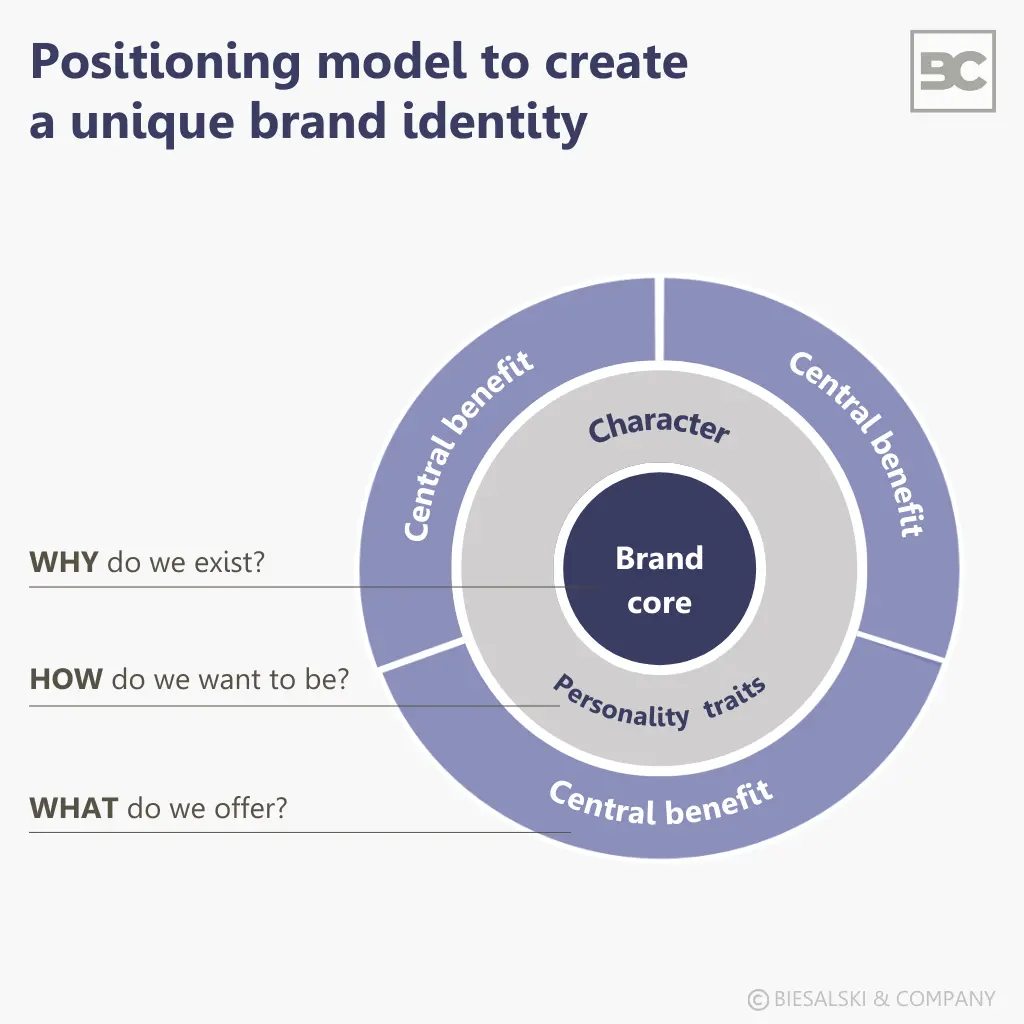Brand strategy
Brand portfolio and brand architecture
Brand identity and positioning
Brand concretisation
Customer journey mapping
Communication idea
Brand-driven innovations
What is a brand identity?
A brand identity comprises all the elements that make up the essence and character of a brand and distinguish it from other brands. These include brand personality, core benefits and Reasons Why, which, when coordinated with each other, form the basis for consistent perception in the target group. The identity also provides orientation for the long-term direction of the company.
What are the success factors of a brand identity?
An effective positioning persuades through relevance, credibility and selectivity. It forms the starting point for professional brand management – only those who know what they stand for, can also communicate this picture to the outside world.
Consequently, a focus on the most significant content is inevitable (keyword: relevance): what are the benefits your brand offers to customers and how can those be justified convincingly through the underlying competences (keyword: credibility)? A successful positioning addresses the needs of the target group and differentiates the brand from competitors (keyword: selectivity). Brand personality, core benefits and reasons why are aligned with each other and thereby lay the foundations for a consistent perception within the target group.
Why is a brand identity important?
Brand identity is critical to building and maintaining a brand’s relationship with its customers. It helps to establish the emotional bond, build trust and foster customer loyalty. A strong and consistent identity ensures that a brand is perceived clearly and unambiguously and communicates its message effectively in every contact with the target group: in sales, on packaging and across all online and offline channels.
Looking inwards, a clear identity always sets a binding framework for the company’s self-image. While the mission statement acts as an orientation anchor for the employees, the brand positioning is directed outwards to the target group. Last but not least, it simplifies a uniform brand identity and thus provides a stable basis for a long-term, strategically managed corporate orientation.
Finally, a successful identity can help to promote the growth and success of a brand by increasing recognition, value and differentiation from the competition.
How is a brand identity built?
When developing a brand identity, companies must consider their target group, corporate values, brand positioning and long-term goals. As a result, brand core, brand personality, central benefits and reasons why are worked out. Even new, forward-looking fields must not be a no-go for a sustainable brand positioning. It should definitely include topics that the brand would like to cover in the future.

What we offer
Based on a clear, convincing as well as motivating and inspiring vision and mission and together with you, we develop a brand positioning that is relevant and differentiating, but at the same time credible.
While doing so, we consistently place emphasis on the most important good of every company: your target group. What are their needs and what is the best way to address these? This ensures that brand positioning is given highest priority. Moreover, we also consider the opponents on the playing field of your brand: your competitors. What benefits do they offer their target groups and what are the underlying competences? With this knowledge, it is possible to specifically and individually work out the unique selling points of your brand. Eventually we reflect together whether your brand can really communicate the promised benefits in a convincing way.
To bring the brand even closer to your target group, we elaborate the personality of your brand. If there are specific characteristics that your target group associates with the brand, these provide the best base for a strong emotional relationship between the brand and your target group.
Your benefit
Benefit from our long-term experience and our structured approach. During the interdisciplinary development process, we include different internal stakeholders from various functional areas that significantly shape the brand experience of customers. This creates acceptance, lays the foundation for commitment and eventually enhances the motivation of employees in the company. All employees have the same understanding of what the brand stands for and what makes it unique. This in turn increases effectiveness and efficiency of internal processes, communication and market development – and ultimately also of your business success.
As a result, you have a comprehensive positioning model that includes brand essence, personality, promises and reasons why. This provides the ideal base to start the communicative, behavioural and procedual implementation and anchor the brand in the minds and hearts of the target group.
In sum, you have the ideal starting point to move into communicative, behavioural and procedural implementation and to anchor the brand in the minds and hearts of the target group.

